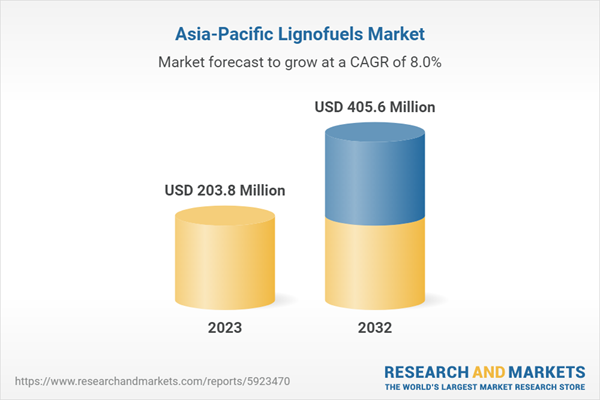Dublin, Jan. 15, 2024 (GLOBE NEWSWIRE) -- The "Asia-Pacific Lignofuels Market: Analysis and Forecast, 2023-2032" report has been added to ResearchAndMarkets.com's offering.
The Asia-Pacific lignofuels market (excluding China) is projected to reach $405.6 million by 2032 from $203.8 million in 2023, growing at a CAGR of 7.95% during the forecast period 2023-2032.
Ongoing research and development efforts have resulted in more advanced techniques for producing lignofuels, increasing their cost efficiency and efficacy and thereby pushing market expansion. Modern technologies in integrated biorefineries, such as Finland's Neste Porvoo Refinery, demonstrate the use of lignocellulosic feedstock for biofuel production. Globally supportive legislation and incentives are propelling the lignofuels industry's rapid growth.
The Renewable Fuel Standard (RFS) in the United States, for example, requires the inclusion of renewable fuels, including cellulosic biofuels, into transportation fuel, assuring a steady market for lignofuels. The Renewable Energy Directive (RED II) specifies targets for renewable energy in transportation throughout the European Union, encouraging the use of biofuels and lignofuels.
The APAC lignofuel market refers to the Asia-Pacific region's market for renewable fuels derived from lignocellulosic biomass sources such as agricultural leftovers, forestry waste, and specific energy crops. Lignofuels, also known as advanced biofuels, are a viable alternative to traditional fossil fuels that help to reduce greenhouse gas emissions.
Concerns about climate change and the demand for sustainable energy sources have led to a rise in interest in lignofuels throughout the Asia-Pacific area. Government initiatives and legislation encouraging the use of renewable energy, together with the region's plentiful biomass resources, have spurred the expansion of the APAC lignofuel industry.
Lignofuels provide various benefits, including lower carbon emissions, increased energy security, and the possibility for rural economic development by employing locally accessible biomass feedstocks. Furthermore, lignofuels can be utilized as a direct substitute for traditional fuels, allowing for a seamless transition in existing infrastructure and automobiles.
Despite increased interest, the APAC lignofuel market is still confronted with constraints such as high production costs, limited commercial-scale implementation, and the need for technological breakthroughs in biomass conversion processes. However, with increased investments in R&D and favorable government legislation, the APAC lignofuel market has great growth potential.
How can this report add value to an organization?
Product/Innovation Strategy: The product segment helps the reader to understand the different sources and processing technology involved in the lignofuels market. The source segment has been segmented into dedicated energy crops, agricultural residue, forest residue, and urban waste. The processing technology segment has been segmented into thermochemical and biochemical. Moreover, the study provides the reader with a detailed understanding of the lignofuels market based on end users, including automotive, aerospace, and marine. The increasing adoption of lignofuels in renewable diesel and sustainable aviation fuel is expected to fuel market growth in the future.
Growth/Marketing Strategy: The Asia-Pacific lignofuels market has seen major development by key players operating in the market, such as business expansions, partnerships, collaborations, mergers and acquisitions, and joint ventures. The favored strategy for the companies has been business partnerships to strengthen their position in the lignofuels market.
Competitive Strategy: Key players in the Asia-Pacific lignofuels market analyzed and profiled in the study involve lignofuels manufacturers and the overall ecosystem. Moreover, a detailed competitive benchmarking of the players operating in the lignofuels market has been done to help the reader understand how players stack against each other, presenting a clear market landscape.
Additionally, comprehensive competitive strategies such as partnerships, agreements, acquisitions, and collaborations will aid the reader in understanding the untapped revenue pockets in the market.
Key Attributes:
| Report Attribute | Details |
| No. of Pages | 83 |
| Forecast Period | 2023 - 2032 |
| Estimated Market Value (USD) in 2023 | $203.8 Million |
| Forecasted Market Value (USD) by 2032 | $405.6 Million |
| Compound Annual Growth Rate | 7.9% |
| Regions Covered | Asia Pacific |
Key Topics Covered:
1 Market
1.1 Industry Outlook
1.1.1 Trends: Current and Future
1.1.1.1 Market Competitiveness Promoting Commercial Deployment of Low-Cost Lignofuels
1.1.1.2 Sustainability Standards Playing a Vital Role in Promoting Lignofuels
1.1.2 Supply Chain Analysis
1.1.3 Cost Break-Up of Lignofuels (Cellulosic Ethanol) Plant
1.2 Business Dynamics
1.2.1 Business Drivers
1.2.1.1 Government Policies Benefiting Lignofuels
1.2.1.2 Collaborative Efforts of Government and Manufacturers for Promoting Sustainable Biofuels
1.2.1.3 Availability of Waste and Residues Feedstock to Benefit Lignofuels
1.2.2 Business Challenges
1.2.2.1 Slower Commercialization of Lignofuels
1.2.2.2 Variation in Feedstock Prices Across Regions and Countries
1.2.3 Business Strategies
1.2.3.1 Product and Market Developments
1.2.4 Corporate Strategies
1.2.4.1 Mergers and Acquisitions, Partnerships, and Joint Ventures
1.2.5 Business Opportunities
1.2.5.1 Trade Opportunities to Benefit Lignofuels
1.2.5.2 Mandates for Blending of Bioethanol
1.3 Start-Up Landscape
1.3.1 Key Start-Ups in the Ecosystem
2 Regions
2.1 China
2.1.1 Market
2.1.1.1 Business Drivers
2.1.1.2 Business Challenges
2.1.2 Application, Volume and Value Data
2.1.2.1 End User
2.1.3 Product, Volume and Value Data
2.1.3.1 Source
2.1.3.2 Processing Technology
2.2 Asia-Pacific and Japan
2.2.1 Market
2.2.1.1 Business Drivers
2.2.1.2 Business Challenges
2.2.2 Application, Volume and Value Data
2.2.2.1 End User
2.2.3 Product, Volume and Value Data
2.2.3.1 Source
2.2.3.2 Processing Technology
2.2.4 Asia-Pacific and Japan (by Country)
2.2.4.2 India
2.2.4.3 ASEAN
2.2.4.4 Rest-of-Asia-Pacific and Japan
3 Market - Competitive Benchmarking and Company Profiles
3.1 Competitive Benchmarking
3.1.1 Competitive Position Matrix
3.2 Company Profiles
3.2.1 Praj Industries
3.2.1.1 Overview
3.2.1.2 Top Products / Product Portfolio
3.2.1.3 Top Competitors
3.2.1.4 Target Clients/End User
3.2.1.5 Market Share
3.2.1.6 Analyst View
3.2.1.7 Key Personnel
4 Research Methodology
For more information about this report visit https://www.researchandmarkets.com/r/r4wdij
About ResearchAndMarkets.com
ResearchAndMarkets.com is the world's leading source for international market research reports and market data. We provide you with the latest data on international and regional markets, key industries, the top companies, new products and the latest trends.
Attachment
